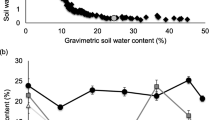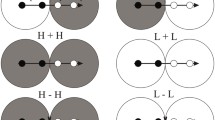Abstract
The effects of applying glyphosate to the root zone of one of a pair of connected ramets were investigated. In the low root density (LRD) treatment, daughter ramet roots were exposed to 100 mL of 10 mg L−1 glyphosate, while in the high root density (HRD) treatment, mother ramet roots were exposed to the same glyphosate solution. These treatments were compared to unexposed controls. The morphologies (leaf and shoot numbers) of control and HRD treatments were identical. In these treatments, daughter ramets had greater numbers of leaves and shoots than mother ramets. The morphology of the LRD treatment was opposite: mother ramets had more leaves and shoots than daughter ramets. Growth parameters were unaffected by glyphosate exposure except for relative growth rate, which was significantly greater for the HRD treatment. This study provides insights about the responses of clonal plants to physiological integration and spatially heterogeneous environmental stressors.








Similar content being viewed by others
References
Alpert, P. (1996). Nutrient sharing in natural clonal fragments of Fragaria chiloensis. Journal of Ecology, 84, 395–406.
Alpert, P., & Mooney, H. A. (1986). Resource sharing among ramets in the clonal herb, Fragaria chiloensis. Oecologia, 70, 227–233.
Bayer, D. E., & Rejmánková, E. (1990). Removal of herbicide residua and nitrates from agricultural waters by aquatic plants (WRC Project W-727). Riverside: Report of Water Resources Center, University of California. 32 pp.
Belz, R. G., & Duke, S. O. (2014). Herbicides and plant hormesis. Pest Management Science, 70, 698–707.
Belz, R. G., Cedergreen, N., & Duke, S. O. (2011). Herbicide hormesis—can it be useful in crop production? Weed Research, 51, 321–332.
Borggaard, O. K., & Gimsing, A. L. (2008). Fate of glyphosate in soil and the possibility of leaching to ground and surface waters: a review. Pest Management Science, 64, 441–456.
Bouldin, J. L., Farris, J. L., Moore, M. T., Smith, S., Jr., & Cooper, C. M. (2006). Hydroponic uptake of atrazine and lambda-cyhalothrin in Juncus effusus and Ludwigia peploides. Chemosphere, 65, 1049–1057.
Cedergreen, N. (2008). Is the growth stimulation by low doses of glyphosate sustained over time? Environmental Pollution, 156, 1099–1104.
Clua, A., Conti, M., & Beltrano, J. (2012). The effects of glyphosate on the growth of Birdsfoot Trefoil (Lotus corniculatus) and its interaction with different phosphorus contents in soil. Journal of Agricultural Science, 4, 208–218.
D’hertefeldt, T., & van der Putten, W. (1998). Physiological integration of the clonal plant Carex arenaria and its response to soil-borne pathogens. Oikos, 81, 229–237.
Dandelot, S., Verlaque, R., Dutarte, A., & Cazaubon, A. (2005). Ecological, dynamic and taxonomic problems due to Ludwigia (Onagraceae) in France. Hydrobiologia, 551, 131–136.
de Carvalho, L. B., Alves, P. L. C. A., & Duke, S. O. (2013). Hormesis with glyphosate depends on coffee growth stage. Annals of the Brazilian Academy of Sciences, 85, 813–821.
de Kroon, H., & Hutchings, M. J. (1995). Morphological plasticity in clonal plants: the foraging concept reconsidered. Journal of Ecology, 83, 143–152.
de Kroon, H., & Knops, J. (1990). Habitat exploration through morphological plasticity in two chalk grassland perennials. Oikos, 59, 39–49.
de Kroon, H., & van Groenendael, J. (Eds.). (1997). The ecology and evolution of clonal plants. Leiden: Backhuys Publishers. 453 p.
Dewey, S.A. (1981). Manipulation of assimilate transport patterns as a method of studying glyphosate translocation in tall morning glory [Ipomoea purpurea (L.) Roth] [dissertation]. Oregon State University. 127 p.
Duke, S. O. (1988). Glyphosate. In P. C. Kearney & D. D. Kaufman (Eds.), Herbicides: chemistry, degradation, and mode of action (pp. 1–70). New York: Marcel Dekker.
Edwards, W. M., Triplett, G. B., & Kramer, R. M. (1980). A watershed study of glyphosate transport in runoff. Journal of Environmental Quality, 9, 661–665.
Ellmore, G. S. (1981). Root dimorphism in Ludwigia peploides (Onagraceae): structure and gas content of mature roots. American Journal of Botany, 68, 557–568.
Evans, J. P., & Cain, M. L. (1995). A spatially explicit test of foraging behavior in a clonal plant. Ecology, 76, 1147–1155.
Evans, J. P., & Whitney, S. (1992). Clonal integration across a salt gradient by a nonhalophyte, Hydrocotyle bonariensis (Apiaceae). American Journal of Botany, 79, 1344–1347.
Frantzen, J. (1994). The role of clonal growth in the pathosystem Cirsium arvense—Puccinia punctiformis. Canadian Journal of Botany, 72, 832–836.
Geiger, D. R., Shieh, W. J., & Fuchs, M. A. (1999). Causes of self-limited translocation of glyphosate in Beta vulgaris plants. Pesticide Biochemistry and Physiology, 64, 124–133.
Gérard, J., Brion, N., & Triest, L. (2014). Effect of water column phosphorus reduction on competitive outcome and traits of Ludwigia grandiflora and L. peploides, invasive species in Europe. Aquatic Invasions, 9, 157–166.
Giesy, J. P., Dobson, S., & Solomon, K. R. (2000). Ecotoxicological risk assessment for Roundup® herbicide. Reviews of Environmental Contamination and Toxicology, 167, 35–120.
Guo, W., & Hu, Z. H. (2012). Effects of stolon severing on the expansion of Alternanthera philoxeroides from terrestrial to contaminated aquatic habitats. Plant Species Biology, 27, 46–52.
Hester, M. W., McKee, K. L., Burdick, D. M., Koch, M. S., Flynn, K. M., Patterson, S., & Mendelssohn, I. A. (1994). Clonal integration in Spartina patens across a nitrogen and salinity gradient. Canadian Journal of Botany, 72, 767–770.
Hussner, A. (2010). Growth response and root system development of the invasive Ludwigia grandiflora and Ludwigia peploides to nutrient availability and water level. Fundamental and Applied Limnology Archiv für Hydrobiologie, 177, 189–196.
Jónsdóttir, I. S., & Watson, M. A. (1997). Extensive physiological integration: an adaptive trait in resource-poor environments? In H. De Kroon & J. van Groenendael (Eds.), The ecology and evolution of clonal plants (pp. 109–136). Leiden: Backhuys Publishers.
Kirby, K. J. (1980). Experiments on vegetative reproduction in bramble (Rubus vestitus). Journal of Ecology, 68, 513–520.
Kui, L., Li, F., Moore, G., & West, J. (2013). Can the riparian invader, Arundo donax, benefit from clonal integration? Weed Research, 53, 370–377.
Li, Q., Liu, X., Yue, M., Zhang, X. F., & Zhang, R. C. (2011). Effects of physiological integration on photosynthetic efficiency of Trifolium repens in response to heterogeneous UV-B radiation. Photosynthetica, 49, 539–545.
Liu, F. H., Liu, J., Yu, F. H., & Dong, M. (2007). Water integration patterns in two rhizomatous dune perennials of different clonal fragment size. Flora, 202, 106–110.
Outridge, P. M., & Hutchinson, T. C. (1990). Effects of cadmium on integration and resource allocation in the clonal fern Salvinia molesta. Oecologia, 84, 215–223.
Peltzer, D. A. (2002). Does clonal integration improve competitive ability? A test using aspen (Populus tremuloides [Salicaceae]) invasion into prairie. American Journal of Botany, 89, 494–499.
Pennings, S. C., & Callaway, R. M. (2000). The advantages of clonal integration under different ecological conditions: a community-wide test. Ecology, 81, 709–716.
Poor, A., Hershock, C., Rosella, K., & Goldberg, D. E. (2005). Do physiological integration and soil heterogeneity influence clonal growth and foraging in Schoenoplectus pungens? Plant Ecology, 181, 45–56.
Radford, P. J. (1967). Growth analysis formulae—their use and abuse. Crop Science, 7, 171–175.
Rejmánková, E. (1992). Ecology of creeping macrophytes with special reference to Ludwigia peploides (H.B.K.) Raven. Aquatic Botany, 43, 283–299.
Roiloa, S. R., & Retuerto, R. (2006). Development, photosynthetic activity and habitat selection of the clonal plant Fragaria vesca growing in copper-polluted soil. Functional Plant Biology, 33, 961–971.
Roiloa, S. R., Antelo, B., & Retuerto, R. (2014). Physiological integration modifies δ15N in the clonal plant Fragaria vesca, suggesting preferential transport of nitrogen to water-stressed offspring. Annals of Botany, 144, 399–411.
Salzman, A. G., & Parker, M. A. (1985). Neighbors ameliorate local salinity stress for a rhizomatous plant in a heterogeneous environment. Oecologia, 65, 273–277.
Saunders, L. E., & Pezeshki, R. (2014). Sublethal effects of environmentally relevant runoff concentrations of glyphosate in the root-zone on Ludwigia peploides (creeping water primrose) and Polygonum hemitomon (smartweed). Weed Biology and Management, 14, 242–250.
Savini, G., Giorgio, V., Scarano, E., & Neri, D. (2008). Strawberry plant relationship through the stolon. Physiologia Plantarum, 134, 421–429.
Stuefer, J. F., & Hutchings, M. J. (1994). Environmental heterogeneity and clonal growth: a study of the capacity for reciprocal translocation in Glechoma hederacea L. Oecologia, 100, 302–308.
Stuefer, J. F., Gómez, S., & van Mӧlken, T. (2004). Clonal integration beyond resource sharing: implications for defense signaling and disease transmission in clonal plant networks. Evolutionary Ecology, 18, 647–667.
USEPA Technical Overview of Ecological Risk Assessment. (2012). United States Environmental Protection Agency. http://www.epa.gov/oppefed1/ecorisk_ders/toera_analysis_exp.htm. Accessed 11 Oct 2014.
Velini, E. D., Alves, E., Godoy, M. C., Meschede, D. K., Souza, R. T., & Duke, S. O. (2008). Glyphosate applied at low doses can stimulate plant growth. Pest Management Science, 64, 489–496.
Wagner, R., Kogan, M., & Parada, A. M. (2003). Phytotoxic activity of root absorbed glyphosate in corn seedlings (Zea mays L.). Weed Biology and Management, 3, 228–232.
Yu, F., Dong, M., & Krüsi, B. (2004). Clonal integration helps Psammochloa villosa survive sand burial in an inland dune. New Phytologist, 162, 697–704.
Zhang, Y. C., Zhang, Q. Y., Yirdaw, E., Luo, P., & Wu, N. (2008). Clonal integration of Fragaria orientalis driven by contrasting water availability between adjacent patches. Botanical Studies, 49, 373–383.
Acknowledgments
The authors are grateful to The University of Memphis Department of Biological Sciences for providing space and support to carry out this study. The assistance of Dr. Melissa Koontz and Dr. Samuel Pierce is greatly appreciated.
Conflict of Interest
The authors declare that they have no conflict of interest.
Author information
Authors and Affiliations
Corresponding author
Rights and permissions
About this article
Cite this article
Saunders, L.E., Pezeshki, R. Morphological Differences in Response to Physiological Integration and Spatial Heterogeneity of Root Zone Glyphosate Exposure in Connected Ramets of Ludwigia peploides (Creeping Water Primrose). Water Air Soil Pollut 226, 171 (2015). https://doi.org/10.1007/s11270-015-2435-1
Received:
Accepted:
Published:
DOI: https://doi.org/10.1007/s11270-015-2435-1




